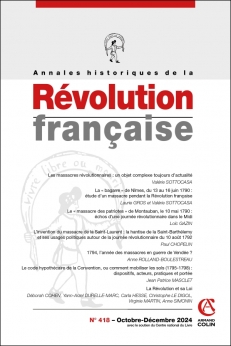
ANNALES HISTORIQUES DE LA RÉVOLUTION FRANÇAISE Nº418 (4/2024)
Pour acheter ce numéro, contactez-nous
Recevez les numéros de l'année en cours et accédez à l'intégralité des articles en ligne.
La Convention thermidorienne a voté le 27 juin 1795 un code hypothécaire de 331 articles. Ce code a été mis en application par une équipe dirigeante menée par un conservateur général, Jean Baptiste Jollivet, assisté de 527 conservateurs dans la France entière. À partir de novembre 1795, ce réseau a inscrit des milliers d’hypothèques et assuré la publicité de centaines de ventes. Grâce aux registres subsistant dans douze départements au moins, on peut connaître les rentes, les prêts, leurs montants, les identités des contractants. L’activité des conservateurs, inégale selon les lieux, a permis le maintien d’une activité de prêts en pleine crise monétaire. L’opposition des milieux d’affaires à ce dispositif et à ses acteurs fut constante. Relayée aux Conseils, elle obtint l’abrogation du code au profit de la loi du 11 brumaire an VII, améliorée à certains égards, mais sans cédule. Il restait la publicité des ventes, supprimée en 1804. Dès 1812, l’application du code hypothécaire fut niée. Elle l’est encore de nos jours. La suppression de la publicité des ventes jusqu’à la loi du 17 mars 1855, en entravant la création de caisses de prêts hypothécaires durant un demi-siècle, a durablement éloigné les propriétaires franc¸ais d’un important accès aux capitaux.
On June 27, 1795, the Thermidorian Convention passed a mortgage code of 331 articles. This code was implemented by a management team led by a Conservateur Général, Jean Baptiste Jollivet, assisted by 527 conservators throughout France. From November 1795 onwards, this network recorded thousands of mortgages and advertized hundreds of sales. Thanks to surviving registers in at least twelve départements, it is now possible to identify annuities, loans, amounts, and the identities of contracting parties. The activity of the curators, which varied from place to place, enabled lending to continue amid a monetary crisis. Opposition to this business community and its agents, however, was constant. Relayed to the Councils, the repeal of the code in favor of the law of 11 Brumaire An VII was obtained, and even improved in certain respects, but without a “cédule.” What remained was the advertising of sales, abolished in 1804. Beginning in 1812, the application of the mortgage code was refused; it is still denied today. The suppression of publicity of sales until the creation of the law of March 17, 1855 by hindering the creation of mortgage loan funds for half a century lastingly distanced French property owners from an important access to capital.